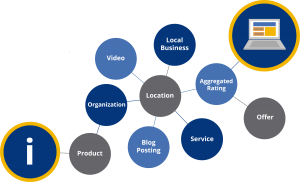
For most of us, the new year brings with it hope, plans, resolutions, and predictions. Such is the case in the SEO world when John Mueller, Webmaster Trends Analyst at Google®, offered some insights for SEO firms to focus on this year while as a guest in a webinar hosted by Ashley Berman Hale, Technical SEO Lead at DeepCrawl.
According to John, there are four main topics Google plans to focus on in 2019:
- Mobile-first indexing – including AMP for faster mobile page speed
- Structured data – aka Schema Markup, Rich Results
- JavaScript
- The new Google Search Console
Explanations about terminology and meaning have been added in the summary below. John’s views are in italics.
Mobile-first indexing
In March 2018, Google rolled out an algorithm called mobile-first indexing. Mobile-first indexing means that Google uses the mobile version of websites for indexing and ranking rather than the desktop version.
Being indexed this way has no ranking advantage and operates independently of Google’s mobile-friendly assessment of a site.
While this change occurred in 2018, updating a website for fast indexing on its mobile platform has risen in importance to compete in 2019’s digital space.
- More sites will be pure AMP or parts of sites will be AMP.
- AMP is a language that makes mobile versions faster, but sites can be fast without AMP too.
- AMP teams will move towards making the technology available for more “normal” mobile web pages.
- Currently, it is challenging to include many of the deluxe features that desktop web pages often include when coding in AMP – such as revolving screens or interactive items. Hopefully, this means AMP will be updated to allow these features.
- On behalf of website developers for Top Of The List clients, we will be digging into AMP to bring them the latest information we find to them.
Structured data

So how do we define these terms? Schema markup translates your website’s content into the language of search engines, making websites stand out and attract the right target audience far more than if they do not include the markup. It connects related things to make sense of the vast information on the Internet.
Google uses structured data in two ways:
- In SERP (Search Engine Result Page) features, many ways which are still in the brainstorm stage
- When you see an image next to a recipe or star ratings below a product on the SERP, this is schema markup working to make those links far more understandable… and more likely to get the click.
- To better understand websites and their content.
- This translates into better placement on what’s important for a website.
John’s recommendations for 2019:
- Website owners should spend time marking up the primary information they want to get across rather than waste time on non-important pages
- Mark up pages now to get ahead of what Google will be launching
- Top Of The List clients are among the first small businesses to receive custom schema markup on their websites, since we adopted this over a year ago. There’s a considerable learning curve and the markup rules themselves continually change, but we’ve got it!
- Rollouts of new algorithms will take place first in the U.S. and migrate to other countries. Policies and laws make the global extension more difficult.
- Q&A markup is heading in the direction of optimizing for voice search, and would be one of the best items to optimize for voice.
JavaScript
Currently, Google has a difficult time crawling and indexing websites that are heavily coded with JavaScript. In October 2018, Google published documentation about using a dynamic rendering method to help search engines crawl and index sites coded with heavy JavaScript.
Often, navigation bars are created in JavaScript, which means search engines might not even crawl pages inside the site. So dynamic rendering is a great strategy to use when developers intend to have Google crawl a site.
Unfortunately, another thing about JavaScript is that it is frequently used to hide spam, redirect users to a different page, and other “bad” things.
While not specifically addressed in John’s webinar interview, we suspect more is coming from Google in 2019 to address the websites not behaving properly when using JavaScript. Black-hatters, beware!
- Google’s guidelines for JavaScript are changing over time
- SEO’s need to have a better working relationship with developers – speak their language, understand their needs and requirements, work more closely with them to accomplish the goals
- Historically, Top Of The List has always worked to keep the relationship with its clients’ and in-house developers very strong!
The new Google Search Console
For those unfamiliar, Google Search Console is a free service offered by Google that helps one monitor, maintain, and troubleshoot a site’s presence in Google Search results. Top Of The List sets up is clients to use this tool, and we do the monitoring along with developers if they so choose.
In January 2018 Google introduced its new Google Search Console. It was rolled out in a way that we could use the old Search Console that we are familiar with, but also use the new one in parallel.
Not all features are complete yet, so both versions are still running. Some features are now blocked on the older platform and require us to use them on the new one.
John gave some additional insights as to further changes to this tool in 2019:
- More reports and data will be combined
- Some reports will go away altogether
- Hope they keep the ones we use most often!
- Data between Google Analytics and Google Search Console will merge over time, ensuring better consistency between the tools
- “Act now” issues that are causing problems for a website will be a focus to help SEOs prioritize on the most important data
- We are already seeing this in direct emails that address website issues.
- More integration with other platforms such as WordPress by bringing the data to the platform rather than the other way around
- We have seen this implemented already, too.
Overall, at Top Of The List, we have our constantly changing (and challenging) strategies to help our clients stay ahead of the curve when competing online. Eyes glazed over yet? Not ours – we eat this stuff up. Happy New Year!
About the Author

Bev founded Top Of The List in 2006 and has over 25 years of experience working with technology. In her free time, she competes in dog agility competitions with her Golden Retrievers, Cosmo, and Finn.




